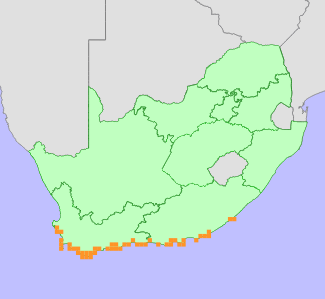|
Scientific Name | Limonium scabrum (Thunb.) Kuntze |
Higher Classification | Dicotyledons |
Family | PLUMBAGINACEAE |
Common Names | Sea Lavender (e) |
National Status |
Status and Criteria | Least Concern |
Assessment Date | 2020/11/27 |
Assessor(s) | D. van der Colff |
Justification | Limonium scabrum is widespread species with an extent of occurrence (EOO) of 136 758 km². It is not in danger of extinction, and is therefore listed as Least Concern. |
Distribution |
Endemism | South African endemic |
Provincial distribution | Eastern Cape, Western Cape |
Range | This species is endemic to South Africa, and is found from the Cape West Coast in the Western Cape to the Fish River in the Eastern Cape. |
Habitat and Ecology |
Major system | Terrestrial |
Major habitats | Subtropical Seashore Vegetation, Bethelsdorp Bontveld, Agulhas Sand Fynbos, Hangklip Sand Fynbos, Atlantis Sand Fynbos, Southern Cape Dune Fynbos, Knysna Sand Fynbos, Elim Ferricrete Fynbos, Transkei Coastal Belt, Potberg Ferricrete Fynbos, Cape Seashore Vegetation, St Francis Dune Thicket, Hamburg Dune Thicket, Kasouga Dune Thicket, Hartenbos Dune Thicket, Grass Ridge Bontveld, Goukamma Dune Thicket, Lourensford Alluvium Fynbos, Kogelberg Sandstone Fynbos, Blombos Strandveld, Overberg Dune Strandveld, Cape Flats Dune Strandveld, Langebaan Dune Strandveld, Saldanha Flats Strandveld, Saldanha Granite Strandveld, Albertinia Sand Fynbos, Potberg Sandstone Fynbos, Groot Brak Dune Strandveld, Canca Limestone Fynbos, De Hoop Limestone Fynbos, Agulhas Limestone Fynbos, Garden Route Shale Fynbos, Garden Route Granite Fynbos, Peninsula Granite Fynbos, Boland Granite Fynbos, Tsitsikamma Sandstone Fynbos |
Description | It occurs in coastal dunes and estuaries. |
Threats |
| Some subpopulations of Limonium scabrum are threatened by habitat loss to urban and coastal development, competition from alien invasive plants, and overgrazing. |
Population |
In spite of some local declines, this species is still very common and not in danger of extinction.
|
Population trend | Stable |
Notes |
| This species is very variable, and a number of varieties have been described, but they are difficult to separate (Dyer 1963), as they overlap in range - sometimes different varieties can be found in the same subpopulation, and therefore it is assessed at species level only. |
Assessment History |
Taxon assessed |
Status and Criteria |
Citation/Red List version | | Limonium scabrum (Thunb.) Kuntze var. scabrum | Least Concern | Raimondo et al. (2009) | | Limonium scabrum (Thunb.) Kuntze var. corymbulosum (Boiss.) R.A.Dyer | Data Deficient (Taxonomically Problematic) | Raimondo et al. (2009) | | Limonium scabrum (Thunb.) Kuntze var. avenaceum (C.H.Wright) R.A.Dyer | Least Concern | Raimondo et al. (2009) | |
Bibliography |
Dyer, R.A. 1963. Plumbaginaceae. In: R.A. Dyer, L.E. Codd and H.B. Rycroft (eds). Flora of southern Africa 26 (Myrsinaceae-Apocynaceae):15-31. Botanical Research Institute, Pretoria.
Goldblatt, P. and Manning, J.C. 2000. Cape Plants: A conspectus of the Cape Flora of South Africa. Strelitzia 9. National Botanical Institute, Cape Town.
Manning, J.C. and Goldblatt, P. 2012. Plants of the Greater Cape Floristic Region 1: The Core Cape Flora. Strelitzia 29. South African National Biodiversity Institute, Pretoria.
Raimondo, D., von Staden, L., Foden, W., Victor, J.E., Helme, N.A., Turner, R.C., Kamundi, D.A. and Manyama, P.A. 2009. Red List of South African Plants. Strelitzia 25. South African National Biodiversity Institute, Pretoria.
|
Citation |
| van der Colff, D. 2020. Limonium scabrum (Thunb.) Kuntze. National Assessment: Red List of South African Plants version 2024.1. Accessed on 2025/10/24 |
 Comment on this assessment
Comment on this assessment

